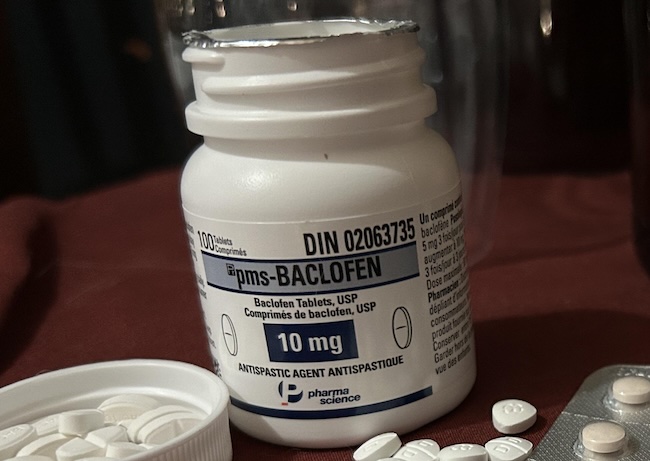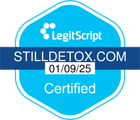Baclofen is not classified as a controlled substance by the Drug Enforcement Administration (DEA) due to its low potential for abuse but Baclofen withdrawal is a fact that should be considered seriously. However, according to the report created by the National Institute of Health, there have been people abusing baclofen to get high in the past several years.
Baclofen, also available as the brand Lioresal, is a generic medication prescribed for the treatment of muscle spasticity. It is commonly used to manage conditions such as spinal cord injuries, cerebral palsy, and multiple sclerosis. Additionally, baclofen is sometimes employed off-label for the treatment of alcohol withdrawal syndrome, though research on its efficacy in this application is not yet extensive.
Key Points
- Baclofen is NOT a narcotic, but withdrawal IS serious. While not classified as a controlled substance due to low abuse potential, baclofen withdrawal can be severe and dangerous.
- Withdrawal mimics benzos/alcohol, and can be life-threatening. Symptoms include seizures, hallucinations, delirium, and severe rebound muscle rigidity.
- Medical detox is essential for safe baclofen withdrawal. Abruptly stopping can be dangerous; professional supervision and gradual tapering are crucial.
- Timeline: Withdrawal starts within hours, peaks in days 3-7, and can last weeks. Intrathecal baclofen withdrawal is particularly rapid and severe.
- Mixing baclofen and alcohol is highly dangerous. It significantly increases CNS depression and risk of severe health consequences.
- If considering stopping baclofen, seek medical advice. Do not attempt to detox alone due to the risk of severe withdrawal complications. Call (561) 556-2677 for support.
Dosages of Baclofen
- Baclofen 10 mg (024 Pill): This dosage is encapsulated in a white, round tablet, marked distinctively with an 024 imprint, embodying the standard visual characteristics of pharmaceutical tablets.
- Baclofen 5 mg (1285 Pill): For a lower dose, Baclofen 5 mg is presented in a smaller, oval-shaped tablet, carrying the 1285 imprint, clearly distinguishing it from higher dosages.
- Additional Dosages: 1330, 4096, and N029 Pills: Baclofen also comes in other specific dosages, each identified by unique imprints like 1330, 4096, and N029, featuring distinct shapes and colors for easy identification.
Is Baclofen a Narcotic?
While baclofen can produce similar effects to narcotics, these usually only occur at very high doses. It does not act on the opioid receptors in the brain, which is a defining characteristic of narcotics.
Is Baclofen Addictive?
However, the published literature on baclofen abuse is sparse. Baclofen abuse is rare, but it can create distressing symptoms. It can become addictive when misused, and over time, the user will need to take more and more of the drug to experience the same sensation as the body begins to develop a tolerance. Baclofen abuse can produce a feeling of euphoria, and users seeking this sensation often mix the drug with opioids, alcohol, or amphetamines. When taken in higher dosages not prescribed by a doctor or when mixed with other substances, baclofen can lead to overdose, which can be fatal.
Baclofen Withdrawal
Baclofen withdrawal can occur in people who take the drug as prescribed or abuse it. Withdrawal symptoms can be similar to those of benzodiazepines and alcohol withdrawal, mainly because both substances interact with GABA in the brain. A person is more likely to go through baclofen withdrawals if they’ve been using it for several months. Withdrawal can also occur in those who use a low or high dose, as symptoms mostly depend on the length of time the person has been using the medication. If someone suddenly stops using baclofen, withdrawal can be severe.
Baclofen Withdrawal Symptoms
Common baclofen withdrawal symptoms include:
- insomnia
- dizziness
- nausea
- disorientation
- delirium
- confusion and memory problems
- hallucinations and delusions,
- anxiety and nervousness,
- changes in perception
- tremors and fever
- hyperthermia
- depersonalization
- psychosis and mania
- mood disturbances,
- changes in behavior
- tachycardia
- seizures
- extreme rebound muscle rigidity and spasticity
Rebound symptoms of the ailments the medication is meant to treat, such as muscle rigidity and spasticity, can occur during baclofen withdrawal.
Withdrawal symptoms tend to be most severe for patients who use the spinal injection version of baclofen.
Baclofen Withdrawal Timeline
First 24–72 Hours: Onset of Symptoms
Withdrawal symptoms often begin within the first day or two after discontinuing baclofen:
- Oral Baclofen: Symptoms such as increased restlessness, heightened spasticity, and difficulty sleeping are common. According to research published in the Journal of Neurology, the disruption of GABA signaling after abrupt cessation often triggers these initial symptoms. [PubMed]
- Intrathecal Baclofen: Symptoms can emerge as quickly as a few hours after discontinuation, especially in cases of pump malfunction. Early signs typically include muscle rigidity, autonomic instability, and confusion. [National Library of Medicine]
Days 3–7: Peak Severity
This period represents the peak of withdrawal severity:
- Neurological symptoms, such as hallucinations, seizures, and delirium, are most pronounced during this phase. Studies from Critical Care Medicine document that individuals withdrawing from intrathecal baclofen may also experience hyperthermia and severe rebound spasticity. [NIH Clinical Insights]
- Physical complications like rhabdomyolysis can occur due to sustained muscle rigidity. Timely medical intervention is crucial to manage these risks.
Weeks 2–4: Gradual Resolution
For most individuals, symptoms begin to subside as the body adjusts to the absence of baclofen:
- Anxiety, mood instability, and insomnia may linger, but physical symptoms, including spasticity and muscle tightness, show noticeable improvement. A review in the Journal of Clinical Neurology highlights that gradual symptom relief can occur with adequate supportive care. [PubMed]
4–8 Weeks: Protracted Withdrawal
For individuals with long-term or high-dose dependence, withdrawal can extend over several weeks:
- Persistent symptoms may include autonomic disturbances and intermittent spasticity. The Annals of Rehabilitation Medicine reports that patients withdrawing from intrathecal baclofen can experience recovery delays of up to two months, especially if the withdrawal was abrupt. [PubMed]
Expert Commentary
“Baclofen withdrawal, especially when it involves intrathecal forms, demands close medical supervision to prevent life-threatening complications such as seizures and autonomic dysregulation,” observed Dr. Sarah Nguyen, a specialist in neurorehabilitation. [Critical Care Insights]
Baclofen Detox
Detoxification from baclofen requires a carefully monitored environment to manage and mitigate the risks associated with withdrawal. Professional detox programs are essential for addressing severe withdrawal symptoms such as seizures, hallucinations, and autonomic instability, which can escalate to life-threatening complications without proper medical care. According to the National Library of Medicine, abrupt cessation of baclofen can lead to significant neurological and physiological disturbances that warrant immediate medical attention.
During a baclofen detox, a patient’s dosage is tapered gradually under close medical supervision. This process helps prevent severe withdrawal symptoms while allowing the body to adapt to the absence of the drug. As noted by the Substance Abuse and Mental Health Services Administration (SAMHSA), gradual tapering is a critical component in reducing the intensity of withdrawal while minimizing risks such as seizures and cardiovascular instability.
Medical professionals in detox programs continuously monitor vital signs, provide interventions to enhance comfort, and address emerging symptoms promptly. The detox process also offers an opportunity to evaluate co-occurring mental health conditions, such as anxiety or depression, which are common among individuals dependent on baclofen. Early identification and treatment of these conditions can significantly improve long-term outcomes, as emphasized in a study published in the Journal of Substance Use and Misuse.
Attempting a baclofen detox independently at home can be extremely hazardous. Without medical oversight, the risk of severe withdrawal complications, including seizures and autonomic instability, increases significantly. A structured detox program ensures safety and provides the necessary medical care to navigate withdrawal effectively, creating a stable foundation for recovery. As the U.S. Food and Drug Administration (FDA) advises, professional detoxification is a critical first step in addressing dependence on medications like baclofen.
How To Manage Baclofen Taper?
A baclofen taper is typically managed through a gradual reduction of the drug’s dosage under medical supervision. The process involves several key steps and considerations:
- Professional Supervision: A baclofen taper should be supervised by medical professionals in a safe environment. This is important to ensure that the taper is conducted effectively and to provide support and medication as needed to manage withdrawal symptoms.
- Tapering Approach: The tapering approach involves slowly reducing the dose of baclofen under supervision. This gradual reduction helps minimize the severity of withdrawal symptoms that can occur during a baclofen detox.
- Medication and Support: Medical professionals may provide medication and support as needed to ensure a safe and effective detox process. This can include the use of pharmacologic adjuncts to treat associated symptoms and to manage the tapering process.
- Recognition of Symptoms: Patients and medical attendants should be aware of the symptoms of baclofen withdrawal. If symptoms of withdrawal appear during the cessation period, the patient may need to adjust the tapering schedule and, in some cases, temporarily increase the dose before resuming the taper.
Duration of Baclofen Taper
Baclofen taper can vary based on individual circumstances, including the patient’s normal dose, the length of time the drug was taken, and the method of discontinuation. A typical taper may last several weeks, and the rate of reduction can vary depending on the individual’s needs and response to the taper.
How Long Does Baclofen Stay In Your System?
Baclofen is known for its relatively short half-life, which typically ranges between 2 and 6 hours. This means that it usually takes between 10 and 20 hours for the drug to be eliminated from the body under normal circumstances. However, several factors can influence this timeline, including the dosage, frequency of use, individual metabolism, and any underlying health conditions. As noted in a study from the National Library of Medicine, variations in renal function significantly affect baclofen clearance, as the drug is primarily excreted through the kidneys.
Standard testing methods reveal different detection windows for baclofen based on the type of test used. Urine tests can generally detect baclofen for up to two days, while blood tests can identify the drug for at least 24 hours following the last dose. According to research published in the Journal of Analytical Toxicology, these timelines reflect typical usage scenarios and may extend in cases of higher dosages or impaired renal function.
In instances of overdose or prolonged use, baclofen may remain detectable in the body for longer periods. For example, urine tests have shown traces of the drug for up to 10 days in such cases. Similarly, the drug may persist in blood tests beyond the standard 24-hour window. The FDA highlights that individual factors, such as body mass, hydration levels, and concurrent use of other medications, can also impact the rate at which baclofen is metabolized and excreted. [FDA Guidance]
Dangers of Mixing Alcohol and Baclofen
The combination of alcohol and baclofen significantly increases the risk of severe health consequences, affecting both physical and mental well-being. Both substances act as central nervous system (CNS) depressants, slowing brain activity and vital bodily functions. “Mixing baclofen with alcohol can dangerously suppress the central nervous system, leading to life-threatening respiratory depression and other critical health issues,” said Dr. Suzette M Evans.
Some individuals may mix these substances in search of relief from stress or to manage alcohol withdrawal symptoms. However, this combination often leads to profound drowsiness, confusion, impaired motor skills, and poor judgment. These effects increase the risk of accidents, injuries, and long-term health complications. A study in the Journal of Substance Use highlights that combining these substances significantly elevates the chances of dependency and dangerous withdrawal symptoms.
More severe outcomes, such as seizures, are not uncommon when alcohol and baclofen are mixed. Repeated use can exacerbate physical dependency on both substances, leading to withdrawal syndromes that are both uncomfortable and medically risky. According to the Substance Abuse and Mental Health Services Administration (SAMHSA), withdrawal from alcohol and baclofen can include intense anxiety, tremors, and in extreme cases, life-threatening complications like delirium or seizures. Addressing this combination without medical supervision is particularly dangerous and can result in devastating outcomes.
Baclofen Overdose Symptoms
Overdose symptoms include;
- muscle weakness,
- vomiting,
- drowsiness,
- dilated or pinpoint pupils,
- and weak or shallow breathing.
Medical Detox For Baclofen Withdrawal
Still Detox in Boca Raton, Florida, is the right starting point for overcoming addiction to alcohol or dependence on prescription drugs or narcotics.
Get Help Now: (561) 556-2677
Brand Names of Baclofen
Although baclofen, with its generic name being widely used, has been a staple in prescription medication since 1977 in the United States, it surprisingly lacks any notable street names. This medication, however, is known under several brand names such as Lioresal, Gablofen, and Kemstro, alongside its widely recognized generic name.
Brand Names of Baclofen:
- Baclodol
- Beklo
- Gablofen
- Kemstro
- Lioresal
- Lyflex
Generic Names of Baclofen:
- Apo-baclofen
- Ava-baclofen
- Baclofen (generic name)
How to Manage Baclofen Withdrawal?
Using baclofen can lead to dependence and addiction. The brain’s dependence on the drug, especially its effects on GABA receptors, triggers baclofen withdrawal. This withdrawal can happen even with prescribed use. It’s vital to recognize the signs and symptoms of baclofen withdrawal, as they can be severe and may lead to life-threatening consequences. If you plan to stop using baclofen, it’s crucial to consult a healthcare professional. They often recommend a gradual baclofen taper to safely reduce dependency without triggering severe withdrawal symptoms.
Sources:
- National Library of Medicine Acute Interaction of Baclofen in Combination with Alcohol in Heavy Social Drinkers
- National Library of Medicine Baclofen therapeutics, toxicity, and withdrawal
- JAMA Complications of Baclofen Withdrawal
- Science Direct Baclofen assisted detoxification from…
- Science Direct Death After Acute Withdrawal of Intrathecal Baclofen









